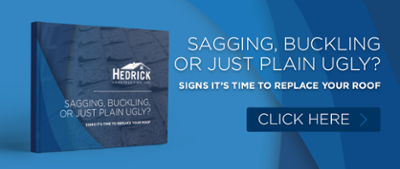.jpg?width=1280&name=Webp.net-compress-image%20(42).jpg)
Because your roof is your home’s first defense against the elements, you want it in its best condition. Many roofing problems can be fixed, but if your roof is sagging, this is a sign that it’s time for a new roof.
Why Is My Roof Sagging?
If your roof is sagging, your first step in getting it fixed is to figure out the cause. One possibility is inadequate structural support. This could be caused by a few things: poor original construction, damage, foundation problems, or natural deterioration over time. As with any structural damage, this is potentially dangerous. If left unfixed, the roof could collapse. While a little bit of sagging doesn’t always mean that your roof is in imminent danger of collapsing, you do need to act quickly to avoid further structural damage to your home.
Sagging can also be caused by excess weight from water, ice, or snow. If this is the case, you may also have a problem with your gutter and drainage systems. When fixing your roof, be sure to address all contributing issues as well. All roofs are designed to support a certain maximum weight. If water pools or snow piles up over time, it could cause your roof to sag.
Problems in your foundation will affect your entire home, including the roof. If your foundation seems to be the problem you’ll need to contact a specialist to solve that issue before roofing work begins.
What Does A Sagging roof look like?
It’s easy to spot sagging roof. You will see a dip on the flat part of your roof, a bow in the roofline, or humps and waviness on the roof plane. If the problem is related to the foundation, you will also begin to see cracks on the exterior walls and uneven support beams. It is important to call a professional to inspect your home’s structure if you see any signs of structural damage.
How Do I Fix It?
There are many possible solutions to a sagging roof. Which may be appropriate for your situation depends on the severity and cause of the sagging. In many cases, a roof needs bolstering for additional support. If your roof is newer and there’s no apparent damage, this could be an effective solution.
If, on the other hand, your roof has outlived its expected lifespan or you can see damage, a replacement will likely be necessary. While bolstering a roof can be a DIY job, it requires knowledge of your roof’s structure and the ability to identify the problem. Don’t attempt any DIY repairs without a good understanding of the process and associated safety hazards. Without this understanding, you’ll be putting your safety and your home at risk.
When in doubt, contact a professional. Many sagging roof issues are complicated and require the expertise that only a trained professional can provide. Also, be sure that you contact the right pros for the job. A roofer can correct a roofing problem, but any structural concerns will need to be addressed first. When the foundation is the source of the problem, the solution begins at the bottom and typically includes adjustments to gutters and downspouts as well. Roofers don’t generally have the skills and tools necessary to correct foundation issues.
You can extend the life of your roof by having it professionally inspected yearly, performing regular preventive maintenance, and attending to issues promptly. Your roof won’t last forever, though. Regular inspections will help you know what issues are simple fixes and what may call for a roof replacement.
For more information about sagging roofs, check out our free guide:








Comments